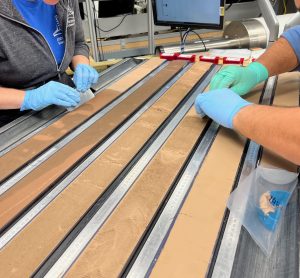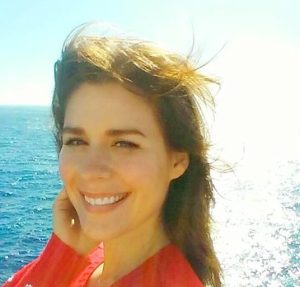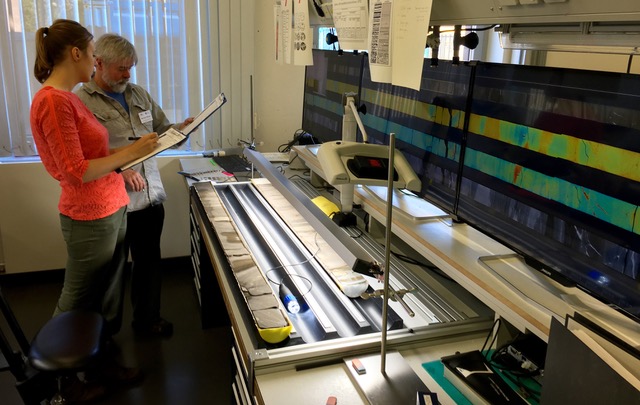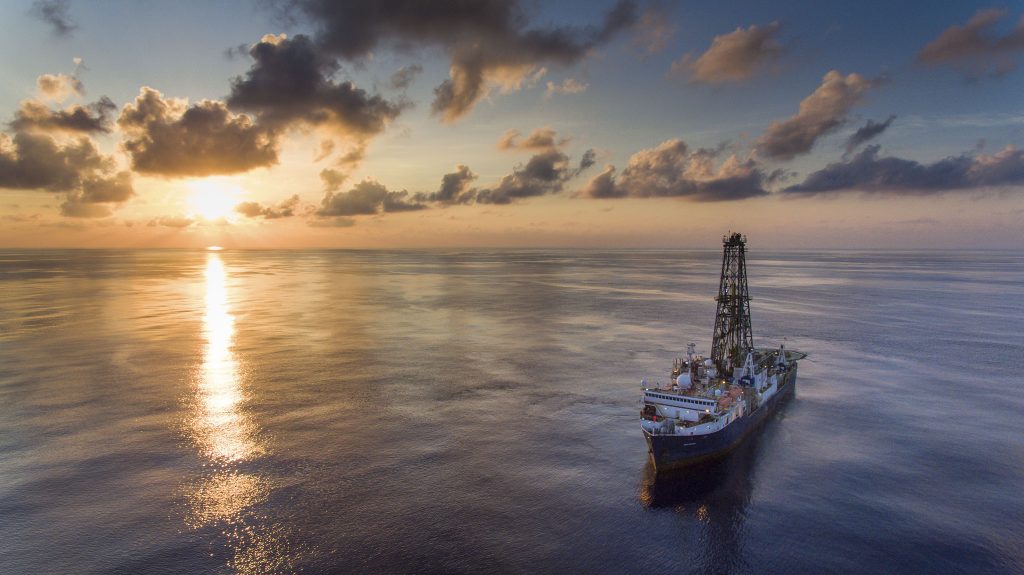Introduction

Research supported by scientific ocean drilling has fundamentally transformed the understanding of the planet, with key scientific contributions to the discovery and understanding of plate tectonics; the formation and destruction of ocean crust and how these processes generate geohazards; the reconstruction of extreme greenhouse and icehouse climates that existed during the past 100 million years; the identification of major extinctions; and the discovery of a diverse community of microbes living in ocean sediments, rocks, and fluids below the seafloor. — Progress and Priorities in Ocean Drilling: In Search of Earth’s Past and Future (National Academies Press, 2024)
The story of scientific ocean drilling begins in 1961, when curious scientists posed questions about Earth’s core/mantle boundary, and then attempted to drill down and sample Earth’s mantle material. Although they did not reach this initial goal, scientists continued on a pathway to recover deep-sea material to learn critical information about Earth’s history, processes and structure. How they did this was by utilizing ships that have the sailing and mechanical capacity to drill at extreme depths to collect seafloor and sub-seafloor material.
Let’s start by viewing this video that was produced in 2011, the 50-year anniversary of scientific ocean drilling. The video will provide a bit more background into how deep-sea sediment and basement rock are collected and utilized to advance our knowledge of Earth’s history and to provide insights into future geohazards, climate impacts, and more.
Now let’s explore additional details of the history of scientific ocean drilling, and how learning about the deep sea through continuous cores continues in the present, and into the future.
Outline of this OER
We begin this Open Educational Resource (OER) with this brief and general Introduction to scientific ocean drilling, followed by an overview of the Research Themes of Scientific Ocean Drilling. We also remind readers of the complexity of the scientific method with How Science Works and a short, high-level review of Sediment and the Subsurface, Plate Tectonics, and Earth System Science. We wrap up this chapter with an introduction to Ocean Literacy and its connections to scientific ocean drilling.
Chapter 2 of the OER looks at the early ideas held by scientists that started the pathway to scientific ocean drilling. We begin with a quick review of Early Ocean Exploration starting with the 1872 Challenger Expedition, then highlight a few additional early oceanographic research vessels. We move on to the efforts of the American Miscellaneous Society and The Start of Scientific Ocean Drilling. The chapter on Project Mohole provides a solid background for this expedition, from the initial planning to completed core recovery, along with with an exciting UPDATE – Mantle Rock Recovered. The chapter wraps up with a discussion of the formation of the JOIDES institutions (not the ship, just the academic institutions critical to the start of this research program).
We continue in Chapter 3 with an overview of Scientific Ocean Drilling Vessels to take the reader through the ships and platforms that have made the collection of deep-sea continuous cores possible. Starting with the first scientific drilling vessel CUSS 1, readers will explore the ships essential to scientific ocean drilling activities through time – Glomar Challenger, JOIDES Resolution, Chikyū, and Mission-Specific Platforms (MSPs). We also include a look into the newest drilling vessel from China, Meng Xiang.
The next several chapters provide details about Ship Operations (Chapter 4), Drilling at Sea (Chapter 5), Shipboard Laboratories (Chapter 6), and Onboard and Onshore Curation (Chapter 7). Readers can also do a deeper dive into Select Scientific Ocean Drilling Expeditions and Discoveries (Chapter 8) and learn additional short narratives from Essential Stories of Scientific Ocean Drilling (Chapter 9). We also highlight Why Scientific Ocean Drilling Matters (Chapter 10).
Our final section provides additional print and multimedia material for not only students but anyone interested in learning more about scientific ocean drilling through Books and Reports, Articles, Audio and Video, and Resources for Educators.
What We Are Highlighting
Any publication on scientific ocean drilling needs to go beyond the drilling process at sea. Here, we make a commitment to call attention to the full community necessary for the successful acquisition of core material and further investigations after the ships return to port.
It Takes More Than Scientists
Our text and media materials incorporate broad representation to showcase diversity in the scientific ocean drilling community, from the range of careers to the individuals that participate from across the globe. Graduate students, technicians, publicists, drillers, shipboard chefs, and more are essential to the success of the scientific mission. We want the profiles and descriptions we include to inform and inspire those exploring a way to participate in and contribute to ocean discovery.
SciOD Spotlight – Publications specialist Alyssa Stephens

Throughout our OER, you will come across SciOD Spotlights. These boxes will bring attention to various individuals and teams critical to carrying out the objectives and contributing to the success of scientific ocean drilling.For example, here we spotlight Alyssa Stephens, who worked as a publications specialist on JOIDES Resolution. In this audio clip, Alyssa shares her background as a non-scientist, the role of a publications specialist and how it is a critical piece for science communication, and one of her unofficial job duties as the fun coordinator. Alyssa welcomed this role in helping everyone balance time spent on research with meeting people and making social connections.
Science on Shore
Although this book focuses much of its content on how science sampling and analyses have been carried out on scientific ocean drilling vessels, specifically JOIDES Resolution, we call attention to the existing and continuing opportunities to work on legacy core material held at core repositories. In addition, we want to emphasize to the next generation of scientists that to study ocean material, one is not required to head out to sea.
SciOD Spotlight – Onshore scientist Mike Whalen

Carbonate sedimentologist and stratigrapher Mike Whalen (IODP EXP 364) has been studying ocean material his entire career – but has never stepped foot on a ship.
The Exploration Continues
At the time we authored this OER, the International Ocean Discovery Program (IODP) officially concluded in 2024. JOIDES Resolution is no longer sailing as part of IODP, while Chikyū and mission-specific platforms will continue to collect cores from the seafloor. The international scientific ocean drilling community is moving forward with innovative collaborations and partnerships for exploration, and the amazing record of legacy cores still hold undiscovered knowledge about Planet Earth. We hope our OER will inform and inspire those seeking fascinating historical information as well as those considering the exciting opportunities that exist in the future of scientific ocean drilling.
Laura Guertin, Elizabeth Doyle, Tessa Peixoto


